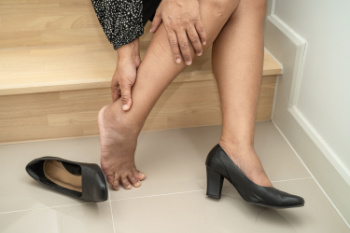Connect With Us
Blog
Items filtered by date: July 2025
Heel Pain and Finding Relief From Plantar Fasciitis

Plantar fasciitis is a common foot condition characterized by inflammation of the thick band of tissue connecting the heel to the toes. It is often caused by repetitive strain, overuse, tight calf muscles, or footwear that lacks adequate support. Risk factors include obesity, prolonged standing, high arches, and certain types of exercise. Symptoms usually include sharp heel pain, especially with the first steps in the morning or after periods of rest. A podiatrist can diagnose plantar fasciitis with a thorough examination and recommend stretching exercises, orthotic devices, and anti-inflammatory measures. If you have heel pain, it is strongly suggested that you consult a podiatrist who can accurately diagnose and treat plantar fasciitis.
Plantar fasciitis can be very painful and inconvenient. If you are experiencing heel pain or symptoms of plantar fasciitis, contact Elie C. Daniel, DPM from Illinois. Our doctor can provide the care you need to keep you pain-free and on your feet.
What Is Plantar Fasciitis?
Plantar fasciitis is the inflammation of the thick band of tissue that runs along the bottom of your foot, known as the plantar fascia, and causes mild to severe heel pain.
What Causes Plantar Fasciitis?
- Excessive running
- Non-supportive shoes
- Overpronation
- Repeated stretching and tearing of the plantar fascia
How Can It Be Treated?
- Conservative measures – anti-inflammatories, ice packs, stretching exercises, physical therapy, orthotic devices
- Shockwave therapy – sound waves are sent to the affected area to facilitate healing and are usually used for chronic cases of plantar fasciitis
- Surgery – usually only used as a last resort when all else fails. The plantar fascia can be surgically detached from the heel
While very treatable, plantar fasciitis is definitely not something that should be ignored. Especially in severe cases, speaking to your doctor right away is highly recommended to avoid complications and severe heel pain. Your podiatrist can work with you to provide the appropriate treatment options tailored to your condition.
If you have any questions please feel free to contact our offices located in Princeton, Peru, and Mendota, IL . We offer the newest diagnostic and treatment technologies for all your foot and ankle needs.
Are Bunions Affecting Your Everyday Life?
Common Conditions That Cause Foot Pain

Foot pain can stem from several common conditions, including plantar fasciitis, tendonitis, and bunions. Plantar fasciitis is caused by inflammation of the tissue connecting the heel to the toes, often due to overuse or poor footwear. It is one of the most common causes of foot pain, affecting over two million Americans each year. Tendonitis, especially in the Achilles or peroneal tendons, results from repetitive stress. Bunions are bony bumps that form at the base of the big toe, often due to genetics or wearing improper shoes. These conditions can cause sharp or aching pain, swelling, stiffness, and difficulty walking. You may notice redness, a bump near a toe, or discomfort that worsens with activity. A podiatrist may recommend orthotics, stretching exercises, anti-inflammatory medications, or, in severe cases, surgical correction. If you have foot pain, it is suggested that you schedule an appointment with a podiatrist for an accurate diagnose and appropriate treatment.
Foot Pain
Foot pain can be extremely painful and debilitating. If you have a foot pain, consult with Elie C. Daniel, DPM from Illinois. Our doctor will assess your condition and provide you with quality foot and ankle treatment.
Causes
Foot pain is a very broad condition that could be caused by one or more ailments. The most common include:
- Bunions
- Hammertoes
- Plantar Fasciitis
- Bone Spurs
- Corns
- Tarsal Tunnel Syndrome
- Ingrown Toenails
- Arthritis (such as Gout, Rheumatoid, and Osteoarthritis)
- Flat Feet
- Injury (from stress fractures, broken toe, foot, ankle, Achilles tendon ruptures, and sprains)
- And more
Diagnosis
To figure out the cause of foot pain, podiatrists utilize several different methods. This can range from simple visual inspections and sensation tests to X-rays and MRI scans. Prior medical history, family medical history, and any recent physical traumatic events will all be taken into consideration for a proper diagnosis.
Treatment
Treatment depends upon the cause of the foot pain. Whether it is resting, staying off the foot, or having surgery; podiatrists have a number of treatment options available for foot pain.
If you have any questions, please feel free to contact our offices located in Princeton, Peru, and Mendota, IL . We offer the newest diagnostic and treatment technologies for all your foot care needs.
Safe Exercises for Common Foot Conditions

Exercise can support healing and strength for many foot conditions when done at the right level. Gentle stretching and strengthening movements may help improve flexibility and reduce discomfort. It is important to aim for minimal or acceptable pain during activity, which means a mild ache that does not increase or linger. Excessive pain, sharp discomfort, or swelling after exercise may signal overuse or improper technique. A podiatrist can recommend specific exercises based on your condition, monitor progress, and guide you on safe intensity. If you have ongoing foot pain or are unsure of which stretches are best, it is suggested that you visit a podiatrist to create a plan that supports recovery, mobility, and long-term foot health.
Stretching the feet is a great way to prevent injuries. If you have any concerns with your feet consult with Elie C. Daniel, DPM from Illinois. Our doctor will assess your condition and provide you with quality foot and ankle treatment.
Stretching the Feet
Being the backbone of the body, the feet carry your entire weight and can easily become overexerted, causing cramps and pain. As with any body part, stretching your feet can serve many benefits. From increasing flexibility to even providing some pain relief, be sure to give your feet a stretch from time to time. This is especially important for athletes or anyone performing aerobic exercises, but anyone experiencing foot pain or is on their feet constantly should also engage in this practice.
Great ways to stretch your feet:
- Crossing one leg over the others and carefully pull your toes back. Do 10-20 repetitions and repeat the process for each foot
- Face a wall with your arms out and hands flat against the wall. Step back with one foot and keep it flat on the floor while moving the other leg forward. Lean towards the wall until you feel a stretch. Hold for 30 seconds and perform 10 repetitions for each foot
- Be sure not to overextend or push your limbs too hard or you could risk pulling or straining your muscle
Individuals who tend to their feet by regular stretching every day should be able to minimize foot pain and prevent new problems from arising.
If you have any questions, please feel free to contact our offices located in Princeton, Peru, and Mendota, IL . We offer the newest diagnostic and treatment technologies for all your foot care needs.
Early Attention Matters for Diabetic Foot Care

Diabetic foot problems can affect both type 1 and type 2 diabetics, often caused by poor circulation and nerve damage. These issues reduce the ability to feel pain, heat, or injury, often leading to unnoticed wounds or infections. A less commonly known complication is Charcot foot, a condition where the bones weaken and shift, leading to deformity if not treated early. Symptoms may include tingling, numbness, burning, or changes in skin color and temperature. The foot may appear swollen, red, or warm, even without pain. Over time, ulcers or infections may develop, which can become serious if not addressed. A podiatrist can assess diabetic foot health with a comprehensive exam, checking for circulation, nerve response, and skin integrity. Treatment may include wound care, custom footwear, offloading devices, and education on daily foot care. If you are dealing with this ongoing condition, it is suggested that you make an appointment with a podiatrist for evaluation and treatment.
Diabetic foot care is important in preventing foot ailments such as ulcers. If you are suffering from diabetes or have any other concerns about your feet, contact Elie C. Daniel, DPM from Illinois. Our doctor can provide the care you need to keep you pain-free and on your feet.
Diabetic Foot Care
Diabetes affects millions of people every year. The condition can damage blood vessels in many parts of the body, especially the feet. Because of this, taking care of your feet is essential if you have diabetes, and having a podiatrist help monitor your foot health is highly recommended.
The Importance of Caring for Your Feet
- Routinely inspect your feet for bruises or sores.
- Wear socks that fit your feet comfortably.
- Wear comfortable shoes that provide adequate support.
Patients with diabetes should have their doctor monitor their blood levels, as blood sugar levels play such a huge role in diabetic care. Monitoring these levels on a regular basis is highly advised.
It is always best to inform your healthcare professional of any concerns you may have regarding your feet, especially for diabetic patients. Early treatment and routine foot examinations are keys to maintaining proper health, especially because severe complications can arise if proper treatment is not applied.
If you have any questions please feel free to contact our offices located in Princeton, Peru, and Mendota, IL . We offer the newest diagnostic and treatment technologies for all your foot and ankle needs.
Recognizing Rheumatoid Arthritis in the Feet

Rheumatoid arthritis in the feet is an autoimmune condition where the immune system attacks the joints, leading to inflammation, pain, and stiffness. It often begins in the small joints of the toes and feet, causing swelling, redness, and difficulty walking. Over time, it may lead to joint deformities and loss of function. The exact cause is unknown, but genetics and environmental triggers may play a role. Risk factors include family history, smoking, and age. A podiatrist can help by evaluating joint function, reducing pain through custom orthotics, and recommending strategies to maintain mobility. If you notice persistent foot pain or swelling, it is strongly suggested that you consult a podiatrist who can offer effective relief and management strategies.
Because RA affects more than just your joints, including the joints in your feet and ankles, it is important to seek early diagnosis from your podiatrist if you feel like the pain in your feet might be caused by RA. For more information, contact Elie C. Daniel, DPM of Illinois. Our doctor will assist you with all of your podiatric concerns.
What Is Rheumatoid Arthritis?
Rheumatoid Arthritis (RA) is an autoimmune disorder in which the body’s own immune system attacks the membranes surrounding the joints. Inflammation of the lining and eventually the destruction of the joint’s cartilage and bone occur, causing severe pain and immobility.
Rheumatoid Arthritis of the Feet
Although RA usually attacks multiple bones and joints throughout the entire body, almost 90 percent of cases result in pain in the foot or ankle area.
Symptoms
- Swelling and pain in the feet
- Stiffness in the feet
- Pain on the ball or sole of feet
- Joint shift and deformation
Diagnosis
Quick diagnosis of RA in the feet is important so that the podiatrist can treat the area effectively. Your doctor will ask you about your medical history, occupation, and lifestyle to determine the origin of the condition. Rheumatoid Factor tests help to determine if someone is affected by the disease.
If you have any questions please feel free to contact our offices located in Princeton, Peru, and Mendota, IL . We offer the newest diagnostic and treatment technologies for all your foot and ankle needs.

